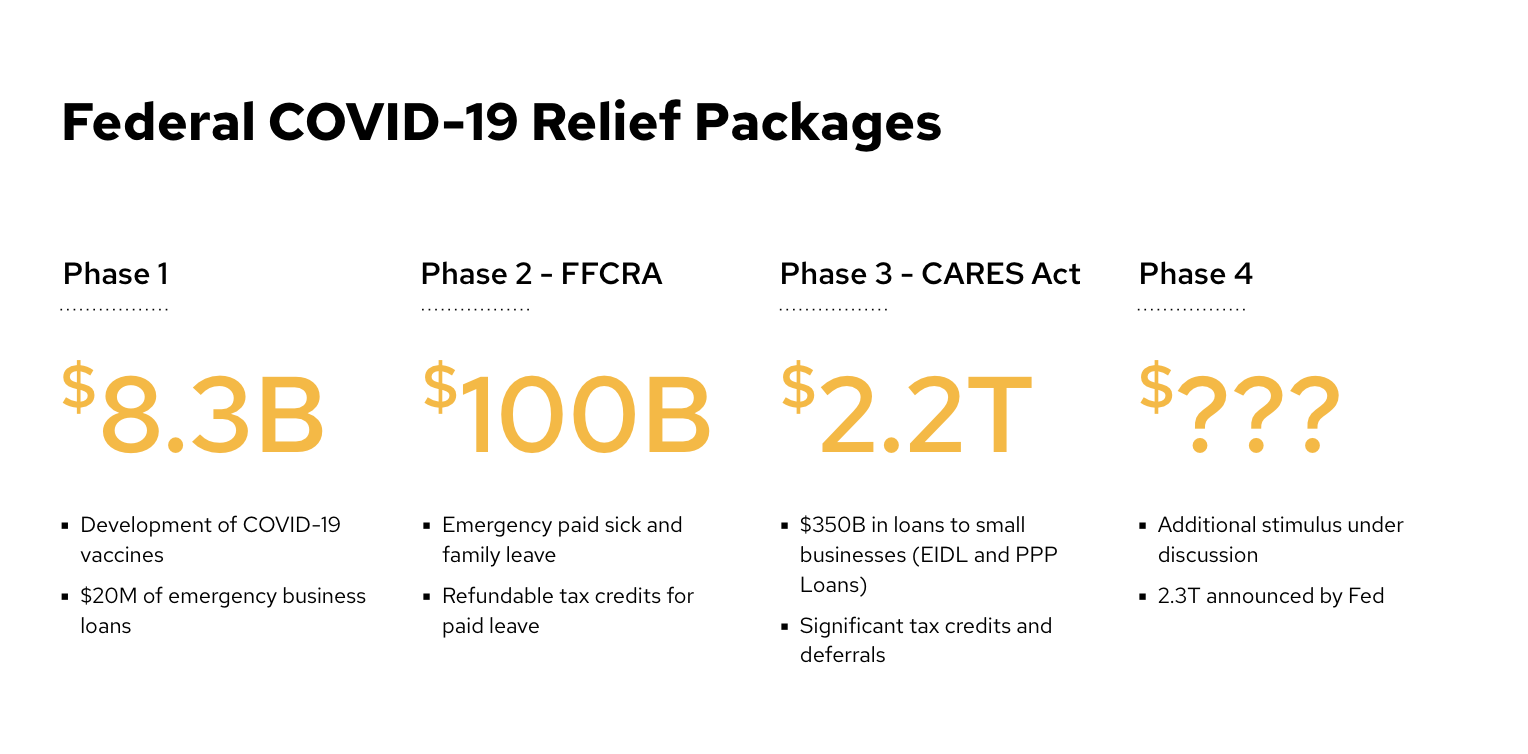The Small Business Owner’s Guide to Federal Aid
FFCRA. CARES. PPP. There are a lot of acronyms floating around since the federal government passed several emergency stimulus packages to rescue the coronavirus-battered economy. The good news is that there’s a significant amount of aid available to both small businesses and their employees. The bad news is that figuring out how it works can be confusing. We’re here to help break it down.

Main Street Lending Program
In an effort to stabilize an economy rocked by historic levels of unemployment, on April 9 the Federal Reserve announced it would make $2.3 trillion available to households, businesses, and state and local governments. That includes $600 billion for new loans and expanding existing loans to small and midsize businesses through the Main Street Lending Program.
Who's eligible? The Main Street program is available to U.S. companies with up to 10,000 employees and less than $2.5 billion in 2019 revenue that were in good financial standing before the COVID-19 crisis.
What are the terms?
- Minimum loan amount of $1 million, max of $25 million
- Companies must make “reasonable efforts” to retain their employees
- Loans will not be eligible for full or partial forgiveness
- Principal and interest payments deferred for one year
- Adjustable rate of SOFR + 250-400 basis points
- Max loan term of 4 years
- No pre-payment penalties
- Businesses can apply for this program AND PPP loans (see below)
The Fed is seeking comments on this program until April 16, and until then the terms are subject to change.
How do I apply? Businesses will need to apply through banks and other lenders authorized to process the loans.
Other details about the application processes haven't been released yet, but lenders aren't expected to accept applications for Main Street loans until the week of April 20. The program expires on Sept 30, 2020.
The CARES Act: A lifeline for SMBs
The CARES Act, which President Trump signed into law on March 27, allocates $360 billion in loans and grants for small businesses as well as nonprofits that meet the size requirements. There are two main programs businesses can tap for financial support during the pandemic: The Paycheck Protection Program (PPP) and the Economic Injury Disaster Loan Program (EIDL). The CARES Act also contains some nifty tax credits we cover in more detail below.
As Vox points out in their excellent guide to the new law, “It’s worth noting that organizations can receive both loans and that an EIDL loan can also be refinanced into a PPP loan.” In other words, organizations can apply for both — and should act fast since both programs are distributing funds on a first come, first serve basis.
EIDL: Emergency cash fast
$10 billion of the CARES Act stimulus is allocated for the Economic Injury Disaster Loan Program (EIDL), an existing SBA program.
Vox explains: “This money will go toward two things: It sets up a grant program that would provide a $10,000 emergency ‘advance’ that businesses won’t have to pay back, and it funds low-interest loans organizations can use to cover operating expenses, though they will have to repay these funds. The loan amount that organizations can request will be based on the amount of ‘economic injury’ that they have sustained because of the coronavirus.”
Companies located in states that have been declared a State of Emergency (most have) are eligible for Economic Disaster Relief Loans of up to $2 million.
Businesses that need cash immediately should consider applying for a $10,000 emergency grant through EIDL. Once a business is approved, they will be able to receive funds within three days according to the SBA.
Who’s eligible? Businesses are required to have been operational on January 31, 2020, and to prove they’ve sustained economic injury. They include:
- Any business with 500 or fewer employees
- Any private nonprofit that has 500 or fewer employees — or otherwise meets the SBA’s size requirements
- Sole proprietorships and independent contractors
- Tribal businesses, cooperatives, and employee-owned businesses
How do I apply? EIDL is administered directly by the SBA. You apply on their website here.
PPP: More money, more uncertainty
Check out our step-by-step guide to getting a PPP loan.
Around $349 billion of the CARES Act is dedicated to establishing the Paycheck Protection Program (PPP), which provides businesses the loans they need to cover eight weeks of payroll, along with some utility and rent costs.
If businesses keep employees on payroll or rehire them by June 30 after they’ve been laid off, these loans could be fully forgiven. Businesses are able to request 2.5 times their average monthly payroll costs for this loan.
It’s worth nothing that there’s a lot of confusion around the PPP because it’s an entirely new program the SBA is trying to get off the ground. Banks were due to start accepting applications today (April 3), but many have said they’re not ready due to a lack of guidance and clear requirements from the Small Business Administration and Treasury Department. We expect that most national banks will release their application processes in the coming week.
Who’s eligible? Businesses are required to have been operational on February 15, 2020, and to demonstrate that the economic fallout from the coronavirus has hurt them. They include:
- Any business with 500 or fewer employees
- Any 501(c)3 nonprofit that has 500 or fewer employees, or otherwise meets the SBA’s size requirements
- Restaurant, hotel, or other business that’s categorized under “Accommodation or Food Services” that has 500 or fewer employees at each of its independent locations
- Tribal businesses and 501(c)9 veterans organizations
- Independently owned franchises
- Self-employed workers, independent contractors, gig workers, and sole proprietors
One of the big questions looming over the program is whether venture capital-backed companies are eligible. Yesterday Congressional leadership indicated that the so-called affiliation rule will be waived for any company with less than 500 employees that doesn't have a controlling outside shareholder, thus making most VC-backed startups eligible for PPP loans.
The National Venture Capital Association (NVCA) has been tracking this issue closely, and plans to post additional guidance when available.
How do I apply? Organizations should contact their bank or participating Section 7(a) lender directly to learn about their application process for PPP. While most national banks will issue their own version of the loan application online, the Treasury Department posted a sample application that will give you a good overview of what to expect.
Payroll tax deferral
As Kruze Consulting notes in their guide for startups, companies that do not receive a SBA loan as part of the CARES Act (e.g. PPP loan or EIDL loan) will be able to immediately defer 100% of their payroll taxes for the remainder of 2020.
Normally, companies pay a payroll tax for social security equal to 6.2% of all employee compensation up to $137,700 per employee. Under this plan, those taxes for the remainder of 2020 will be eligible for deferral – with 50% due in December 2021 and 50% due in December 2022.
Employee retention tax credit
Businesses and nonprofits that do not receive an SBA loan will also be eligible for tax credits. Specifically, companies that have had revenues decline by 50% or more due to COVID-19 will be eligible for significant payroll tax credits that can be applied immediately to your payroll runs.
Contact your payroll provider if you'd like to take advantage of the tax deferral or tax credits.

To recap, businesses have two choices for aid under CARES Act: SBA loans or tax relief
Light at the end of the tunnel?
As devastating as these past weeks and months have been for companies worldwide, small business owners should take heart that there are a growing number of resources to help them stay afloat. In addition to the federal aid programs we discuss here, state and city governments as well as corporations are offering loans and grants for small businesses. Check out Forbes Small Business Relief Tracker for more.
Vanessa Wu is the General Counsel of Rippling where she does lawyerly things.



